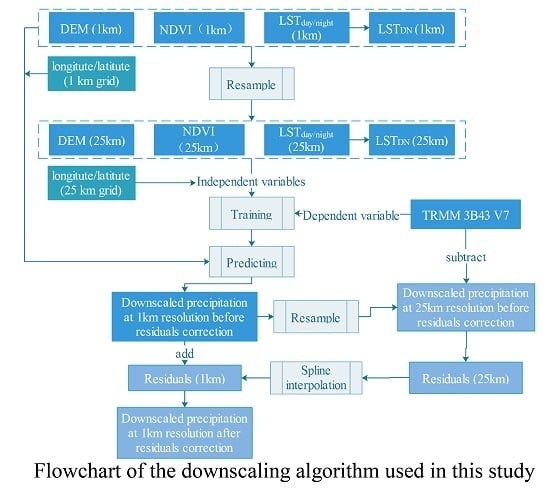A Comparison of Different Regression Algorithms for Downscaling Monthly Satellite-Based Precipitation over North China
Abstract
:1. Introduction
2. Study Area and Data Resources
2.1. Study Area
2.2. Data Resources
3. Methods
3.1. Downscaling Algorithm
- (1)
- For regions with snow, water bodies, and desert-covered areas, NDVI values are usually constantly under 0.0. To eliminate the influences of snow and water bodies, the threshold of NDVI <0.0 was used to distinguish and remove snow and water body pixels from the original monthly NDVI images.
- (2)
- LSTDN was calculated by subtracting LSTnight from LSTday. Additionally, NDVI1km, DEM1km, LSTday-1km, LSTnight-1km, LSTDN-1km were re-sampled to a resolution of 25 km using an averaging method, and the geographical coordinates of the center of each 25 km × 25 km grid were extracted.
- (3)
- The relationships between the re-sampled independent variables and the TRMM 3B43 V7 precipitation data were established using the regression algorithms.
- (4)
- Fine spatial resolution (1 km) variables and the geolocations were input into the model established in step (3), and downscaled precipitation of 1 km resolution (termed PRE1km) was achieved.
- (5)
- Residual correction is an essential step for a downscaling method based on statistical algorithms, and it can correct the precipitation that cannot be predicted by the models. The PRE1km were re-sampled to 25 km using the simple averaging method. Then, the residuals of the models were calculated by subtracting the re-sampled PRE1km from the original TRMM data.
- (6)
3.2. Regression Algorithms
3.2.1. Machine Learning Algorithms
- (1)
- The ntree (number of trees) samples sets are randomly drawn from the original training sample set with replacement. Each sample set is a bootstrap sample, and the elements that are not included in the bootstrap are termed “out-of-bag data” (OOB) for that bootstrap sample.
- (2)
- For each bootstrap sample, an un-pruned regression tree is grown with the modification that a random subset of the variables, from which the best variables are split, is selected at each node.
- (3)
- Predictions for new samples can be made by averaging the predictions from all the individual regression trees:where N is the number of trees and is the prediction from each individual regression tree.
3.2.2. Multiple Linear Regression (MLR) Algorithm
4. Results and Analysis
4.1. Performance of the Different Algorithms
4.2. Downscaled Results
4.3. Validation and Error Analysis
4.4. Variable Importance of Random Forests
5. Discussion
6. Conclusions
Acknowledgments
Author Contributions
Conflicts of Interest
References
- Xie, P.; Xiong, A.-Y. A conceptual model for constructing high-resolution gauge-satellite merged precipitation analyses. J. Geophys. Res. 2011, 116. [Google Scholar] [CrossRef]
- Morrissey, M.L.; Maliekal, J.A.; Greene, J.S.; Wang, J. The uncertainty of simple spatial averages using rain gauge networks. Water Resour. Res. 1995, 31, 2011–2017. [Google Scholar] [CrossRef]
- Villarini, G.; Krajewski, W.F. Empirically-based modeling of spatial sampling uncertainties associated with rainfall measurements by rain gauges. Adv. Water Resour. 2008, 31, 1015–1023. [Google Scholar] [CrossRef]
- Krajewski, W.F.; Smith, J.A. Radar hydrology: rainfall estimation. Adv. Water Resour. 2002, 25, 1387–1394. [Google Scholar] [CrossRef]
- Mandapaka, P.V.; Krajewski, W.F.; Ciach, G.J.; Villarini, G.; Smith, J.A. Estimation of radar-rainfall error spatial correlation. Adv. Water Resour. 2009, 32, 1020–1030. [Google Scholar] [CrossRef]
- Immerzeel, W.W.; Rutten, M.M.; Droogers, P. Spatial downscaling of TRMM precipitation using vegetative response on the Iberian Peninsula. Remote Sens. Environ. 2009, 113, 362–370. [Google Scholar] [CrossRef]
- AghaKouchak, A.; Mehran, A.; Norouzi, H.; Behrangi, A. Systematic and random error components in satellite precipitation data sets. Geophys. Res. Lett. 2012, 39, 1–4. [Google Scholar] [CrossRef]
- Hsu, K.-l.; Gao, X.; Sorooshian, S.; Gupta, H.V. Precipitation estimation from remotely sensed information using artificial neural networks. J. Appl. Meteorol. 1997, 36, 1176–1190. [Google Scholar] [CrossRef]
- Huffman, G.J.; Adler, R.F.; Arkin, P.; Chang, A.; Ferraro, R.; Gruber, A.; Janowiak, J.; McNab, A.; Rudolf, B.; Schneider, U. The Global Precipitation Climatology Project (GPCP) combined precipitation dataset. Bull. Am. Meteorol. Soc. 1997, 78, 5–20. [Google Scholar] [CrossRef]
- Huffman, G.J.; Bolvin, D.T.; Nelkin, E.J.; Wolff, D.B.; Adler, R.F.; Gu, G.; Hong, Y.; Bowman, K.P.; Stocker, E.F. The TRMM Multisatellite Precipitation Analysis (TMPA): Quasi-global, multiyear, combined-sensor precipitation estimates at fine scales. J. Hydrometeorol. 2007, 8, 38–55. [Google Scholar] [CrossRef]
- Ricciardelli, E.; Cimini, D.; Di Paola, F.; Romano, F.; Viggiano, M. A statistical approach for rain intensity differentiation using Meteosat Second Generation–Spinning Enhanced Visible and InfraRed Imager observations. Hydrol. Earth Syst. Sci. 2014, 18, 2559–2576. [Google Scholar] [CrossRef] [Green Version]
- Casella, D.; Dietrich, S.; Di Paola, F.; Formenton, M.; Mugnai, A.; Porcù, F.; Sanò, P. PM-GCD—A combined IR–MW satellite technique for frequent retrieval of heavy precipitation. Nat. Hazards Earth Syst. Sci. 2012, 12, 231–240. [Google Scholar] [CrossRef]
- Di Paola, F.; Casella, D.; Dietrich, S.; Mugnai, A.; Ricciardelli, E.; Romano, F.; Sanò, P. Combined MW-IR Precipitation Evolving Technique (PET) of convective rain fields. Nat. Hazards Earth Syst. Sci. 2012, 12, 3557–3570. [Google Scholar] [CrossRef]
- Di Paola, F.; Ricciardelli, E.; Cimini, D.; Romano, F.; Viggiano, M.; Cuomo, V. Analysis of catania flash flood case study by using combined microwave and infrared technique. J. Hydrometeorol. 2014, 15, 1989–1998. [Google Scholar] [CrossRef]
- Munoz, E.A.; Di Paola, F.; Lanfri, M.; Arteaga, F.J. Observing the troposphere through the Advanced Technology Microwave Sensor (ATMS) to retrieve rain rate. IEEE Lat. Am. Trans. 2016, 14, 586–594. [Google Scholar] [CrossRef]
- Sanò, P.; Panegrossi, G.; Casella, D.; Di Paola, F.; Milani, L.; Mugnai, A.; Petracca, M.; Dietrich, S. The Passive microwave Neural network Precipitation Retrieval (PNPR) algorithm for AMSU/MHS observations: description and application to European case studies. Atmos. Meas. Tech. 2015, 8, 837–857. [Google Scholar] [CrossRef]
- Cimini, D.; Romano, F.; Ricciardelli, E.; Di Paola, F.; Viggiano, M.; Marzano, F.S.; Colaiuda, V.; Picciotti, E.; Vulpiani, G.; Cuomo, V. Validation of satellite OPEMW precipitation product with ground-based weather radar and rain gauge networks. Atmos. Meas. Tech. 2013, 6, 3181–3196. [Google Scholar] [CrossRef]
- Munoz, E.A.; Paola, F.D.; Lanfri, M. Advances on rain rate retrieval from satellite platforms using artificial neural networks. IEEE Lat. Am. Trans. 2015, 13, 3179–3186. [Google Scholar] [CrossRef]
- Kubota, T.; Shige, S.; Hashizume, H.; Aonashi, K.; Takahashi, N.; Seto, S.; Hirose, M.; Takayabu, Y.N.; Ushio, T.; Nakagawa, K.; et al. Global precipitation map using satellite-borne microwave radiometers by the GSMaP project: Production and validation. IEEE Trans. Geosci. Remote Sens. 2007, 45, 2259–2275. [Google Scholar] [CrossRef]
- Funk, C.; Peterson, P.; Landsfeld, M.; Pedreros, D.; Verdin, J.; Shukla, S.; Husak, G.; Rowland, J.; Harrison, L.; Hoell, A.; et al. The climate hazards infrared precipitation with stations—A new environmental record for monitoring extremes. Sci Data 2015, 2, 150066. [Google Scholar] [CrossRef] [PubMed]
- Funk, C.; Verdin, A.; Michaelsen, J.; Peterson, P.; Pedreros, D.; Husak, G. A global satellite-assisted precipitation climatology. Earth Syst. Sci. Data 2015, 7, 275–287. [Google Scholar] [CrossRef]
- Jia, S.; Zhu, W.; Lű, A.; Yan, T. A statistical spatial downscaling algorithm of TRMM precipitation based on NDVI and DEM in the Qaidam Basin of China. Remote Sens. Environ. 2011, 115, 3069–3079. [Google Scholar] [CrossRef]
- Xu, S.; Wu, C.; Wang, L.; Gonsamo, A.; Shen, Y.; Niu, Z. A new satellite-based monthly precipitation downscaling algorithm with non-stationary relationship between precipitation and land surface characteristics. Remote Sens. Environ. 2015, 162, 119–140. [Google Scholar] [CrossRef]
- Chen, C.; Zhao, S.; Duan, Z.; Qin, Z. An improved spatial downscaling procedure for TRMM 3B43 precipitation product using geographically weighted regression. IEEE J. Sel. Top. Appl. Earth Obs. Remote Sens. 2015, 8, 4592–4604. [Google Scholar] [CrossRef]
- Shi, Y.; Song, L.; Xia, Z.; Lin, Y.; Myneni, R.; Choi, S.; Wang, L.; Ni, X.; Lao, C.; Yang, F. Mapping annual precipitation across mainland China in the period 2001–2010 from TRMM3B43 product using spatial downscaling approach. Remote Sens. 2015, 7, 5849–5878. [Google Scholar] [CrossRef]
- Valentine, A.; Kalnins, L. An introduction to learning algorithms and potential applications in geomorphometry and earth surface dynamics. Earth Surf. Dyn. 2016, 4, 445–460. [Google Scholar] [CrossRef]
- Lary, D.J.; Alavi, A.H.; Gandomi, A.H.; Walker, A.L. Machine learning in geosciences and remote sensing. Geosci. Front. 2016, 7, 3–10. [Google Scholar] [CrossRef]
- Trenberth, K.E.; Shea, D.J. Relationships between precipitation and surface temperature. Geophys. Res. Lett. 2005, 32. [Google Scholar] [CrossRef]
- De Kauwe, M.G.; Taylor, C.M.; Harris, P.P.; Weedon, G.P.; Ellis, R.J. Quantifying land surface temperature variability for two sahelian mesoscale regions during the wet season. J. Hydrometeorol. 2013, 14, 1605–1619. [Google Scholar] [CrossRef]
- Xu, X.; Lu, C.; Shi, X.; Ding, Y. Large-scale topography of China: A factor for the seasonal progression of the Meiyu rainband? J. Geophys. Res. 2010, 115. [Google Scholar] [CrossRef]
- The National Meteorological Information Center. Available online: http://data.cma.cn/site/index.html (accessed on 11 October 2016).
- Yang, F.; Lau, K.M. Trend and variability of China precipitation in spring and summer: Linkage to sea-surface temperatures. Int. J. Climatol. 2004, 24, 1625–1644. [Google Scholar] [CrossRef]
- Zhai, P.; Zhang, X.; Wan, H.; Pan, X. Trends in total precipitation and frequency of daily precipitation extremes over China. J. Clim. 2005, 18, 1096–1108. [Google Scholar] [CrossRef]
- Ma, Z. Interannual characteristics of the surface hydrological variables over the arid and semi-arid areas of northern China. Glob. Planet. Chang. 2003, 37, 189–200. [Google Scholar] [CrossRef]
- Li, B.; Tao, S.; Dawson, R.W. Relations between AVHRR NDVI and ecoclimatic parameters in China. Int. J.Remote Sens. 2002, 23, 989–999. [Google Scholar] [CrossRef]
- Jingyong, Z.; Wenjie, D.; Congbin, F.; Lingyun, W. The influence of vegetation cover on summer precipitation in China: A statistical analysis of NDVI and climate data. Adv. Atmos. Sci. 2003, 20, 1002–1006. [Google Scholar] [CrossRef]
- Wan, Z.; Wang, P.; Li, X. Using MODIS land surface temperature and Normalized Difference Vegetation Index products for monitoring drought in the southern Great Plains, USA. Int. J. Remote Sens. 2004, 25, 61–72. [Google Scholar] [CrossRef]
- The National Aeronautics and Space Administration (NASA) Precipitation Measurement Missions (PMM). Available online: http://pmm.nasa.gov/TRMM/trmm-instruments (accessed on 11 October 2016).
- The NASA Land Processes Distributed Active Archive Center (LP DAAC). Available online: https://lpdaac.usgs.gov/ (accessed on 11 October 2016).
- Jarvis, A.; Reuter, H.I.; Nelson, A.; Guevara, E. Hole-Filled SRTM for the Globe Version 4, Available from the CGIAR-CSI SRTM 90m Database. Available online: http://srtm.csi.cgiar.org/ (accessed on 31 January 2016).
- Rokach, L.; Maimon, O. Data Mining with Decision Trees: Theory and Applications; World Scientific Pub Co. Inc.: Singapore, 2008. [Google Scholar]
- Breiman, L.; Friedman, J.H.; Olshen, R.A.; Stone, C.J. Classification and Regression Trees; Chapman and Hall/CRC: Boca Raton, FL, USA, 1984. [Google Scholar]
- Altman, N.S. An introduction to kernel and nearest-neighbor nonparametric regression. Am. Stat. 1992, 46, 175–185. [Google Scholar]
- Ahmad, S.; Kalra, A.; Stephen, H. Estimating soil moisture using remote sensing data: A machine learning approach. Adv. Water Resour. 2010, 33, 69–80. [Google Scholar] [CrossRef]
- Weng, Q. Remote sensing of impervious surfaces in the urban areas: Requirements, methods, and trends. Remote Sens. Environ. 2012, 117, 34–49. [Google Scholar] [CrossRef]
- Mountrakis, G.; Im, J.; Ogole, C. Support vector machines in remote sensing: A review. ISPRS J. Photogramm. Remote Sens. 2011, 66, 247–259. [Google Scholar] [CrossRef]
- Vapnik, V. The Nature of Statistical Learning Theory; Springer: New York, NY, USA, 1995. [Google Scholar]
- Vapnik, V. Statistical Learning Theory; Wiley: New York, NY, USA, 1998. [Google Scholar]
- Gislason, P.O.; Benediktsson, J.A.; Sveinsson, J.R. Random Forests for land cover classification. Pattern Recognit. Lett. 2006, 27, 294–300. [Google Scholar] [CrossRef]
- Breiman, L. Random Forests. Mach. Learn. 2001, 45, 5–32. [Google Scholar] [CrossRef]
- Pedregosa, F.; Varoquaux, G.; Gramfort, A.; Michel, V.; Thirion, B.; Grisel, O.; Blondel, M.; Prettenhofer, P.; Weiss, R.; Dubourg, V.; et al. Scikit-learn: Machine Learning in Python. J. Mach. Learn. Res. 2011, 12, 2825–2830. [Google Scholar]
- Li, C.; Wang, J.; Wang, L.; Hu, L.; Gong, P. Comparison of Classification Algorithms and Training Sample Sizes in Urban Land Classification with Landsat Thematic Mapper Imagery. Remote Sens. 2014, 6, 964–983. [Google Scholar] [CrossRef]
- Harrington, P. Machine Learning in Action; Manning Publications: Greenwich, CT, USA, 2012. [Google Scholar]
- Hand, D.J.; Mannila, H.; Smyth, P. Principles of Data Mining; The MIT Press: Cambridge, MA, USA; London, UK, 2001; p. 546. [Google Scholar]
- Zhang, X.; Friedl, M.A.; Schaaf, C.B.; Strahler, A.H.; Liu, Z. Monitoring the response of vegetation phenology to precipitation in Africa by coupling MODIS and TRMM instruments. J. Geophys. Res. Atmos. 2005, 110. [Google Scholar] [CrossRef]
- Wang, J.; Price, K.P.; Rich, P.M. Spatial patterns of NDVI in response to precipitation and temperature in the central Great Plains. Int. J. Remote Sens. 2001, 22, 3827–3844. [Google Scholar] [CrossRef]
- Vicente-Serrano, S.M.; Gouveia, C.; Camarero, J.J.; Beguería, S.; Trigo, R.; López-Moreno, J.I.; Azorín-Molina, C.; Pasho, E.; Lorenzo-Lacruz, J.; Revuelto, J.; et al. Response of vegetation to drought time-scales across global land biomes. Proc. Natl. Acad. Sci. USA 2013, 110, 52–57. [Google Scholar] [CrossRef] [PubMed] [Green Version]
- Zhong, L.; Ma, Y.; Salama, M.S.; Su, Z. Assessment of vegetation dynamics and their response to variations in precipitation and temperature in the Tibetan Plateau. Clim. Chang. 2010, 103, 519–535. [Google Scholar] [CrossRef]
- Barbosa, H.A.; Huete, A.R.; Baethgen, W.E. A 20-year study of NDVI variability over the Northeast Region of Brazil. J. Arid Environ. 2006, 67, 288–307. [Google Scholar] [CrossRef]
- Barbosa, H.A.; Lakshmi Kumar, T.V. Influence of rainfall variability on the vegetation dynamics over Northeastern Brazil. J. Arid Environ. 2016, 124, 377–387. [Google Scholar] [CrossRef]
- Taylor, C.M.; de Jeu, R.A.M.; Guichard, F.; Harris, P.P.; Dorigo, W.A. Afternoon rain more likely over drier soils. Nature 2012, 489, 423–426. [Google Scholar] [CrossRef] [PubMed] [Green Version]
- Spracklen, D.V.; Arnold, S.R.; Taylor, C.M. Observations of increased tropical rainfall preceded by air passage over forests. Nature 2012, 489, 282–285. [Google Scholar] [CrossRef] [PubMed]
- Guan, H.; Wilson, J.L.; Xie, H. A cluster-optimizing regression-based approach for precipitation spatial downscaling in mountainous terrain. J. Hydrol. 2009, 375, 578–588. [Google Scholar] [CrossRef]
- Yin, Z.Y.; Zhang, X.; Liu, X.; Colella, M.; Chen, X. An assessment of the biases of satellite rainfall estimates over the Tibetan Plateau and correction methods based on topographic analysis. J. Hydrometeorol. 2008, 9, 301–326. [Google Scholar] [CrossRef]
- Sokol, Z.; Bližňák, V. Areal distribution and precipitation-altitude relationship of heavy short-term precipitation in the Czech Republic in the warm part of the year. Atmos. Res. 2009, 94, 652–662. [Google Scholar] [CrossRef]
- Lemone, M.A.; Grossman, R.L.; Chen, F.; Ikeda, K.; Yates, D. Choosing the Averaging interval for comparison of observed and modeled fluxes along aircraft transects over a heterogeneous surface. J. Hydrometeorol. 2003, 4, 179–195. [Google Scholar] [CrossRef]
- Wallace, J.S.; Holwill, C.J. Soil evaporation from tiger-bush in south-west Niger. J. Hydrol. 1997, 188, 426–442. [Google Scholar] [CrossRef]
- Franke, R. Smooth interpolation of scattered data by local thin plate splines. Comput. Math. Appl. 1982, 8, 273–281. [Google Scholar] [CrossRef]
- Chen, F.; Liu, Y.; Liu, Q.; Li, X. Spatial downscaling of TRMM 3B43 precipitation considering spatial heterogeneity. Int. J. Remote Sens. 2014, 35, 3074–3093. [Google Scholar] [CrossRef]
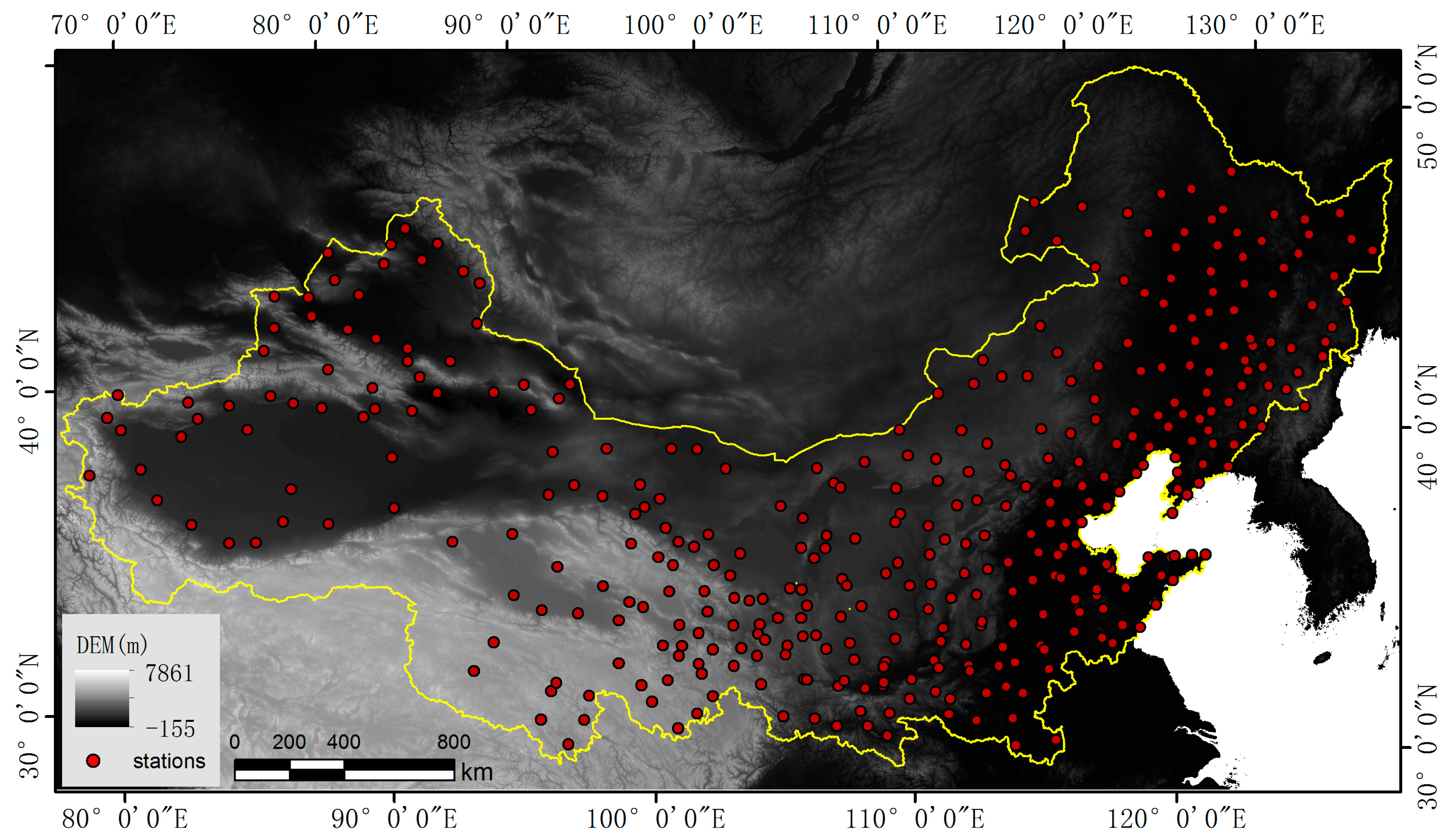
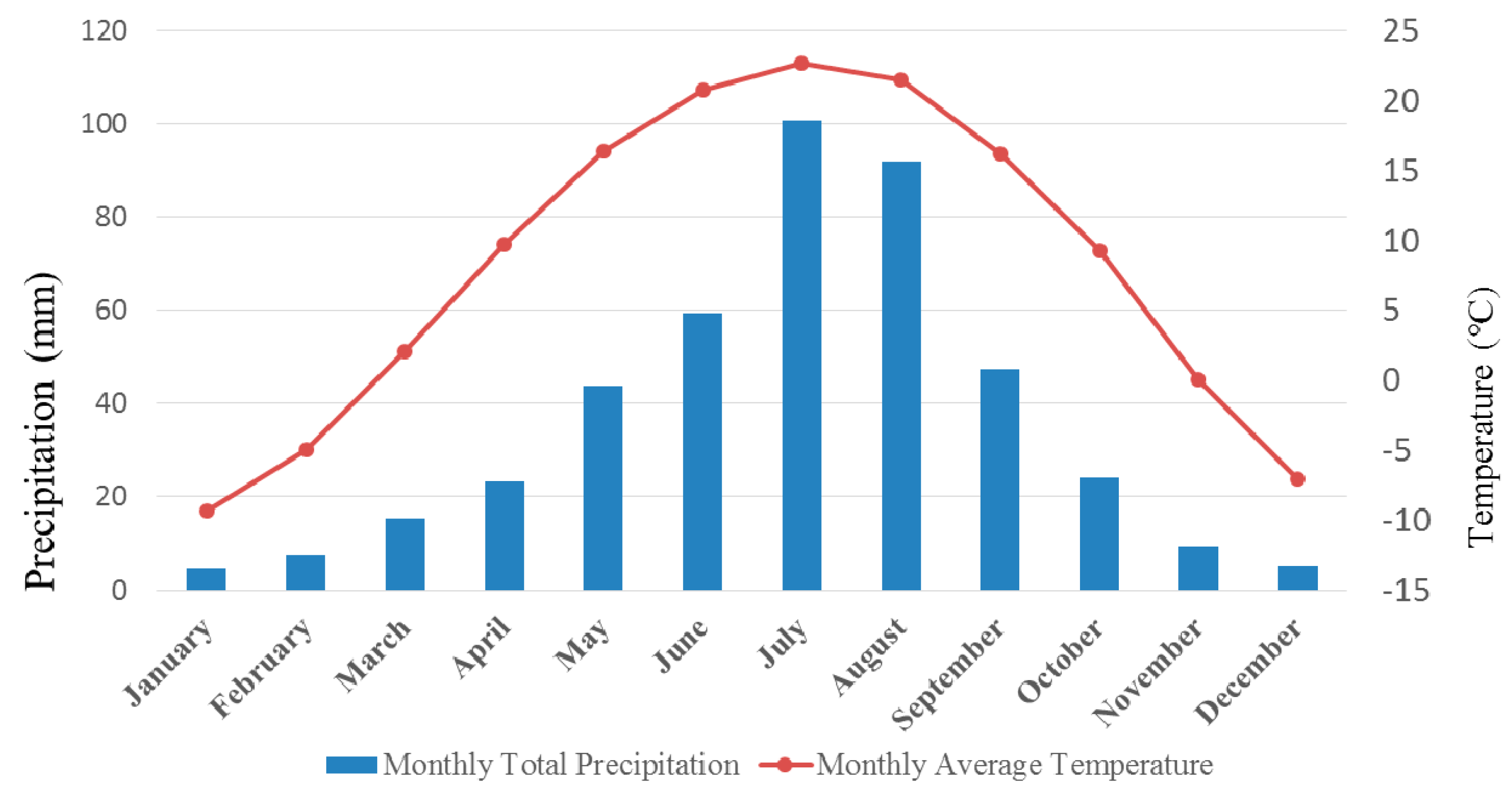


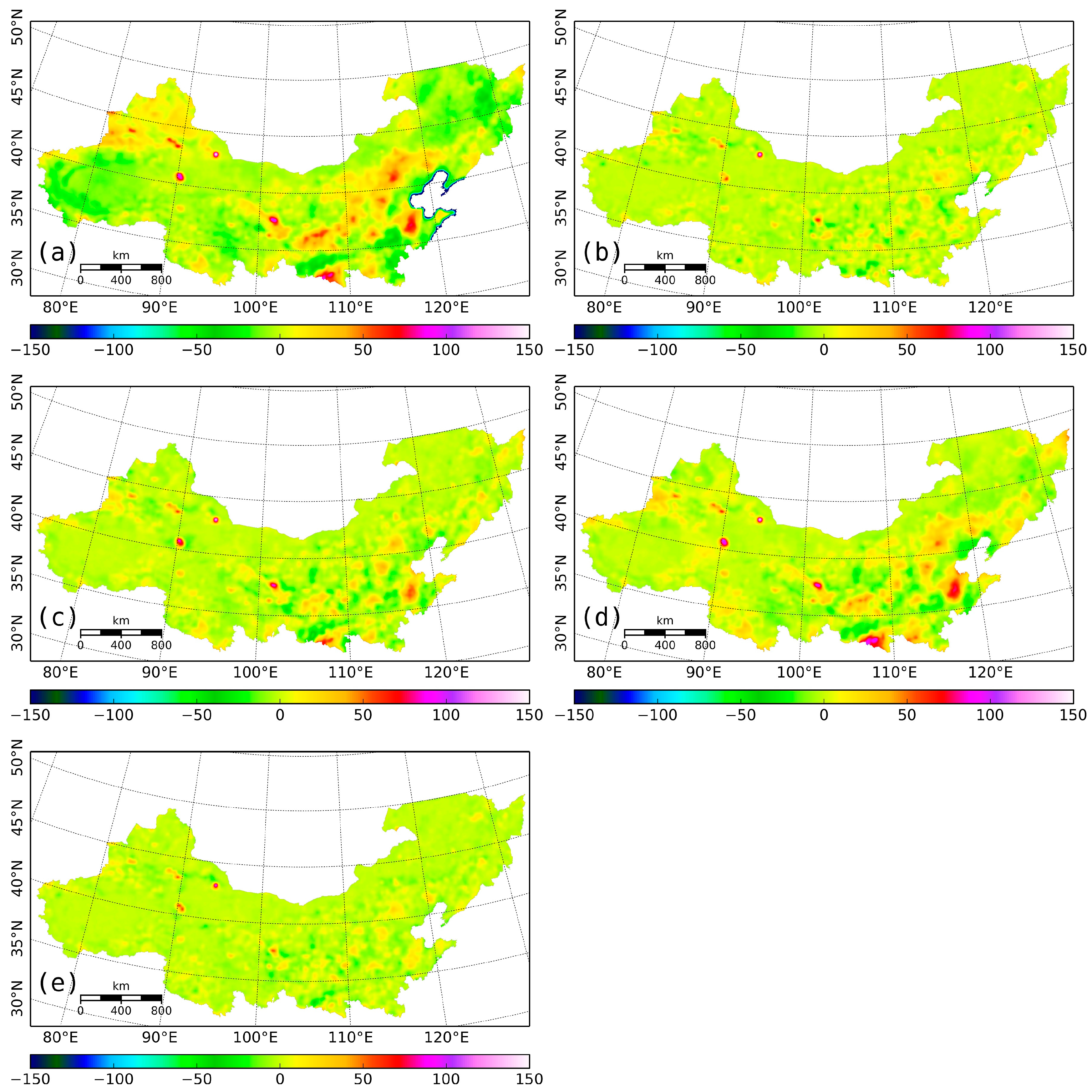
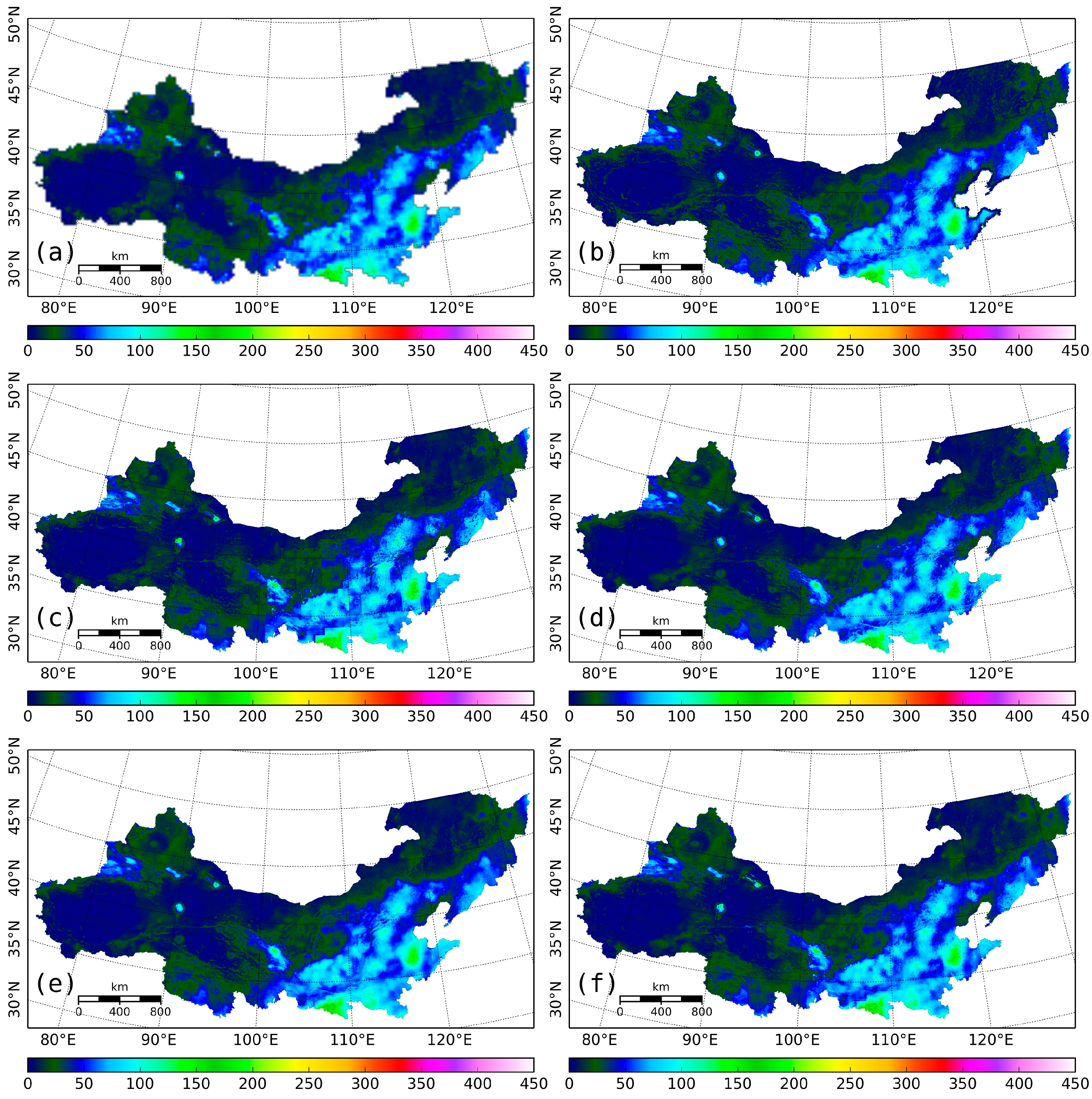
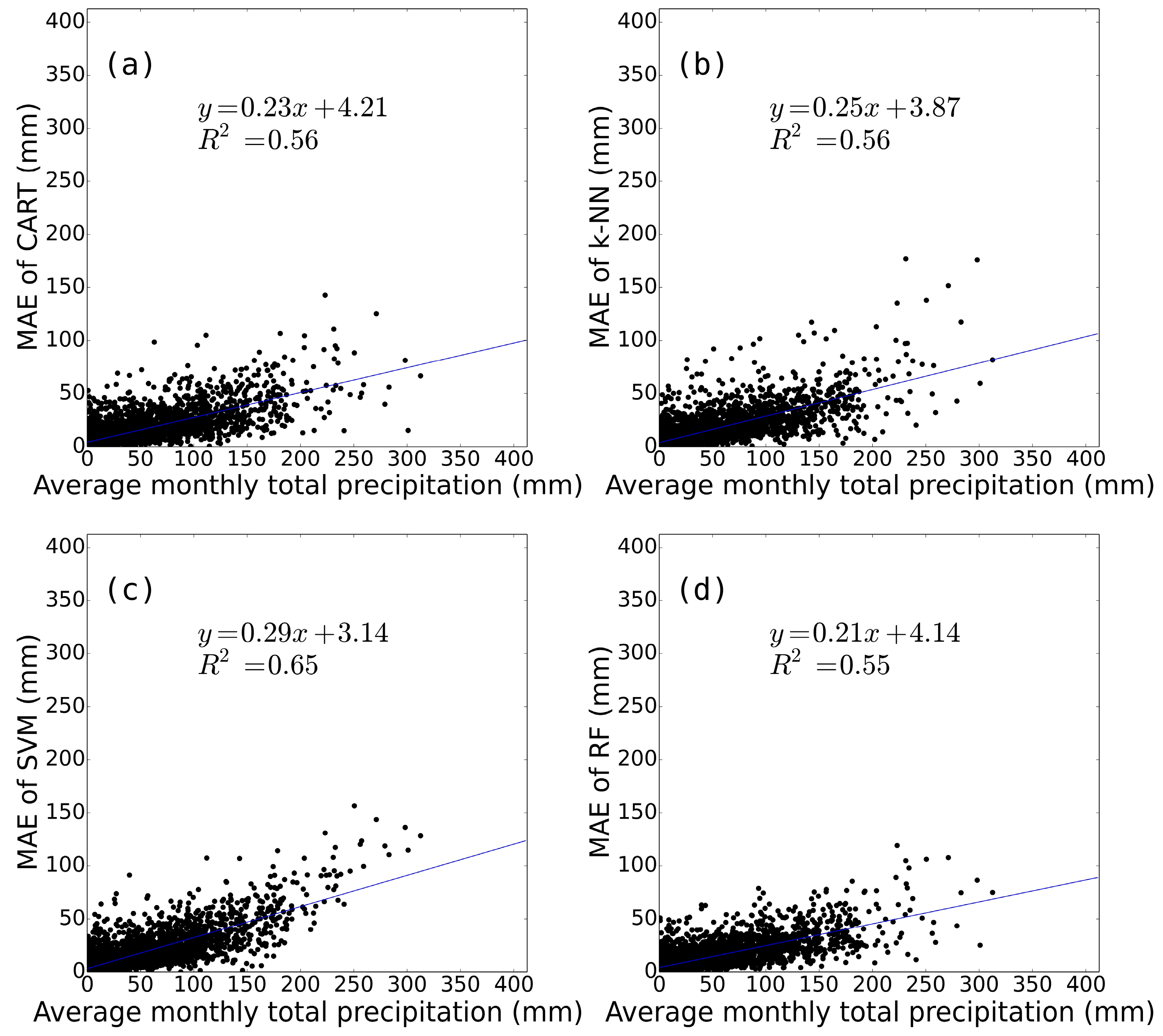

| Algorithm | Abbreviation | Parameter Type | Parameters |
|---|---|---|---|
| Classification and Regression Tree | CART | MinSamplesLeaf | 1, 2, 3, 4, 5, 6, 7, 8, 9, 10 |
| k-Nearest Neighbors | k-NN | n_neighbors | 3, 5, 7, 9, 11, 13, 15, 17, 19 |
| Support Vector Machine | SVM | Kernel | rbf |
| Cost(C) | 20, 40, 60, 80, 100, 150, 200, 220, 250, 280, 300 | ||
| gamma | 2−4, 2−3, 2−2, 2−1, 1, 21, 22, 23, 24 | ||
| Random Forests | RF | n_estimators | 20, 40, 60, 80, 100, 120, 140, 160, 180, 200 |
| Month | MLR | CART | k-NN | SVM | RF | ||||||||||
|---|---|---|---|---|---|---|---|---|---|---|---|---|---|---|---|
| R2 | MAE | RMSE | R2 | MAE | RMSE | R2 | MAE | RMSE | R2 | MAE | RMSE | R2 | MAE | RMSE | |
| (mm) | (mm) | (mm) | (mm) | (mm) | (mm) | (mm) | (mm) | (mm) | (mm) | ||||||
| January | 0.269 | 4.2 | 7.0 | 0.923 | 0.9 | 2.3 | 0.797 | 1.7 | 3.7 | 0.686 | 1.9 | 4.3 | 0.985 | 0.4 | 1.0 |
| February | 0.429 | 4.8 | 7.4 | 0.983 | 0.5 | 1.0 | 0.835 | 2.1 | 4.0 | 0.784 | 2.0 | 4.1 | 0.989 | 0.5 | 1.0 |
| March | 0.457 | 5.2 | 8.2 | 0.943 | 1.1 | 2.4 | 0.838 | 2.4 | 4.5 | 0.704 | 3.1 | 6.1 | 0.985 | 0.7 | 1.3 |
| April | 0.532 | 10.7 | 16.0 | 0.958 | 2.1 | 4.5 | 0.863 | 4.6 | 8.7 | 0.885 | 3.6 | 8.0 | 0.986 | 1.3 | 2.7 |
| May | 0.577 | 13.5 | 18.6 | 0.917 | 4.3 | 7.5 | 0.844 | 6.4 | 10.5 | 0.771 | 7.4 | 12.7 | 0.983 | 1.9 | 3.4 |
| June | 0.663 | 21.9 | 30.8 | 0.951 | 6.1 | 11.1 | 0.888 | 9.8 | 16.4 | 0.653 | 17.7 | 28.8 | 0.989 | 2.9 | 5.1 |
| July | 0.695 | 26.6 | 38.3 | 0.96 | 8.7 | 14.1 | 0.922 | 12.7 | 19.4 | 0.709 | 24.7 | 37.7 | 0.992 | 4.0 | 6.2 |
| August | 0.69 | 24.7 | 35.5 | 0.979 | 5.5 | 9.6 | 0.943 | 9.4 | 15.1 | 0.858 | 14.9 | 25.0 | 0.994 | 3.0 | 5.0 |
| September | 0.58 | 17.0 | 24.1 | 0.962 | 4.7 | 8.1 | 0.933 | 6.6 | 10.8 | 0.84 | 10.1 | 16.7 | 0.992 | 2.1 | 3.6 |
| October | 0.577 | 10.7 | 15.7 | 0.981 | 2.3 | 4.3 | 0.895 | 4.9 | 8.6 | 0.85 | 6.5 | 11.8 | 0.991 | 1.3 | 2.4 |
| November | 0.528 | 6.9 | 10.4 | 0.956 | 1.6 | 3.1 | 0.898 | 2.6 | 4.8 | 0.841 | 3.0 | 5.7 | 0.992 | 0.7 | 1.3 |
| December | 0.349 | 3.9 | 6.0 | 0.919 | 0.7 | 1.5 | 0.843 | 1.1 | 2.2 | 0.718 | 1.5 | 2.9 | 0.987 | 0.3 | 0.6 |
| Average | 0.529 | 12.5 | 18.2 | 0.953 | 2.9 | 5.3 | 0.797 | 1.7 | 3.7 | 0.774 | 7.3 | 12.5 | 0.989 | 1.5 | 2.6 |
| Month | MLR | CART | k-NN | SVM | RF | ||||||||||
|---|---|---|---|---|---|---|---|---|---|---|---|---|---|---|---|
| R2 | MAE | RMSE | R2 | MAE | RMSE | R2 | MAE | RMSE | R2 | MAE | RMSE | R2 | MAE | RMSE | |
| (mm) | (mm) | (mm) | (mm) | (mm) | (mm) | (mm) | (mm) | (mm) | (mm) | ||||||
| January | 0.034 | 4.8 | 13.0 | 0.637 | 3.0 | 5.1 | 0.576 | 3.2 | 5.0 | 0.543 | 3.0 | 4.9 | 0.631 | 3.1 | 5.4 |
| February | 0.039 | 8.2 | 23.1 | 0.721 | 4.3 | 6.7 | 0.715 | 4.2 | 6.1 | 0.637 | 4.4 | 6.7 | 0.77 | 4.1 | 6.0 |
| March | 0.07 | 7.3 | 17.5 | 0.668 | 4.6 | 6.6 | 0.644 | 4.7 | 6.4 | 0.434 | 4.8 | 8.5 | 0.696 | 4.6 | 6.5 |
| April | 0.071 | 18.6 | 56.1 | 0.694 | 10.2 | 15.8 | 0.69 | 9.9 | 14.6 | 0.714 | 9.0 | 13.9 | 0.787 | 9.0 | 12.9 |
| May | 0.21 | 19.9 | 36.8 | 0.597 | 12.9 | 18.2 | 0.61 | 12.9 | 17.4 | 0.605 | 12.7 | 17.6 | 0.69 | 11.4 | 15.5 |
| June | 0.126 | 36.3 | 87.9 | 0.702 | 21.9 | 31.9 | 0.701 | 21.9 | 31.7 | 0.593 | 25.1 | 37.0 | 0.781 | 19.6 | 27.6 |
| July | 0.284 | 43.8 | 70.7 | 0.668 | 30.7 | 42.8 | 0.626 | 31.5 | 44.9 | 0.538 | 37.0 | 50.2 | 0.726 | 28.5 | 38.8 |
| August | 0.227 | 44.3 | 89.6 | 0.656 | 28.0 | 40.9 | 0.642 | 29.0 | 42.3 | 0.632 | 29.3 | 43.7 | 0.729 | 25.6 | 36.7 |
| September | 0.218 | 25.9 | 40.2 | 0.68 | 15.9 | 22.5 | 0.646 | 16.5 | 23.8 | 0.603 | 18.0 | 25.1 | 0.754 | 14.2 | 19.8 |
| October | 0.206 | 18.8 | 45.6 | 0.699 | 10.3 | 16.4 | 0.733 | 10.1 | 15.2 | 0.614 | 11.4 | 18.0 | 0.787 | 9.3 | 13.9 |
| November | 0.079 | 11.7 | 25.5 | 0.735 | 6.5 | 9.5 | 0.703 | 6.6 | 9.6 | 0.716 | 6.3 | 8.9 | 0.792 | 5.9 | 8.2 |
| December | 0.038 | 5.7 | 13.4 | 0.64 | 3.3 | 5.4 | 0.581 | 3.3 | 5.1 | 0.539 | 3.3 | 5.2 | 0.676 | 3.3 | 5.1 |
| Average | 0.133 | 20.4 | 43.3 | 0.677 | 12.6 | 18.5 | 0.657 | 12.8 | 18.5 | 0.597 | 13.7 | 20.0 | 0.736 | 11.6 | 16.4 |
| Month | MLR | CART | k-NN | SVM | RF | ||||||||||
|---|---|---|---|---|---|---|---|---|---|---|---|---|---|---|---|
| R2 | MAE | RMSE | R2 | MAE | RMSE | R2 | MAE | RMSE | R2 | MAE | RMSE | R2 | MAE | RMSE | |
| (mm) | (mm) | (mm) | (mm) | (mm) | (mm) | (mm) | (mm) | (mm) | (mm) | ||||||
| January | 0.355 | 3.5 | 8.3 | 0.604 | 3.0 | 5.7 | 0.559 | 3.2 | 5.9 | 0.572 | 3.0 | 5.8 | 0.593 | 2.9 | 5.8 |
| February | 0.22 | 5.9 | 16.3 | 0.704 | 4.1 | 6.7 | 0.742 | 4.1 | 6.3 | 0.721 | 4.0 | 6.4 | 0.74 | 4.0 | 6.3 |
| March | 0.458 | 5.2 | 9.5 | 0.672 | 4.5 | 6.7 | 0.665 | 4.5 | 6.5 | 0.638 | 4.5 | 6.7 | 0.684 | 4.4 | 6.6 |
| April | 0.382 | 11.8 | 28.4 | 0.728 | 9.7 | 15.1 | 0.775 | 8.9 | 13.1 | 0.768 | 8.5 | 13.1 | 0.794 | 8.5 | 12.4 |
| May | 0.453 | 16.8 | 33.7 | 0.638 | 12.5 | 17.1 | 0.708 | 11.2 | 15.0 | 0.725 | 10.5 | 14.4 | 0.712 | 10.9 | 14.8 |
| June | 0.463 | 25.7 | 48.9 | 0.738 | 20.7 | 29.9 | 0.765 | 20.0 | 28.4 | 0.795 | 18.8 | 26.4 | 0.797 | 18.6 | 26.3 |
| July | 0.538 | 32.8 | 52.1 | 0.723 | 28.5 | 39.2 | 0.71 | 28.3 | 40.2 | 0.777 | 26.1 | 34.7 | 0.76 | 26.2 | 36.1 |
| August | 0.552 | 30.7 | 52.2 | 0.693 | 26.4 | 38.7 | 0.7 | 26.5 | 38.7 | 0.745 | 24.5 | 36.0 | 0.755 | 24.1 | 34.9 |
| September | 0.577 | 16.6 | 27.4 | 0.724 | 14.7 | 21.0 | 0.725 | 14.4 | 21.1 | 0.778 | 13.7 | 19.1 | 0.777 | 13.1 | 18.7 |
| October | 0.617 | 11.4 | 23.4 | 0.739 | 9.9 | 15.2 | 0.799 | 8.9 | 13.4 | 0.802 | 8.4 | 12.6 | 0.808 | 8.8 | 13.1 |
| November | 0.541 | 7.5 | 13.1 | 0.74 | 6.3 | 9.6 | 0.737 | 6.2 | 9.4 | 0.765 | 5.9 | 8.7 | 0.781 | 5.7 | 8.5 |
| December | 0.314 | 3.9 | 8.4 | 0.674 | 3.2 | 5.3 | 0.645 | 3.2 | 5.2 | 0.634 | 3.1 | 5.2 | 0.692 | 3.1 | 5.1 |
| Average | 0.456 | 14.3 | 26.8 | 0.698 | 11.9 | 17.5 | 0.711 | 11.6 | 17.0 | 0.727 | 10.9 | 15.8 | 0.742 | 10.9 | 15.7 |
© 2016 by the authors; licensee MDPI, Basel, Switzerland. This article is an open access article distributed under the terms and conditions of the Creative Commons Attribution (CC-BY) license (http://creativecommons.org/licenses/by/4.0/).
Share and Cite
Jing, W.; Yang, Y.; Yue, X.; Zhao, X. A Comparison of Different Regression Algorithms for Downscaling Monthly Satellite-Based Precipitation over North China. Remote Sens. 2016, 8, 835. https://doi.org/10.3390/rs8100835
Jing W, Yang Y, Yue X, Zhao X. A Comparison of Different Regression Algorithms for Downscaling Monthly Satellite-Based Precipitation over North China. Remote Sensing. 2016; 8(10):835. https://doi.org/10.3390/rs8100835
Chicago/Turabian StyleJing, Wenlong, Yaping Yang, Xiafang Yue, and Xiaodan Zhao. 2016. "A Comparison of Different Regression Algorithms for Downscaling Monthly Satellite-Based Precipitation over North China" Remote Sensing 8, no. 10: 835. https://doi.org/10.3390/rs8100835





